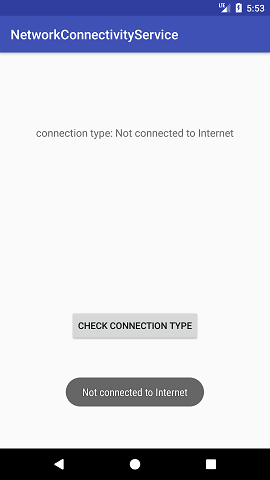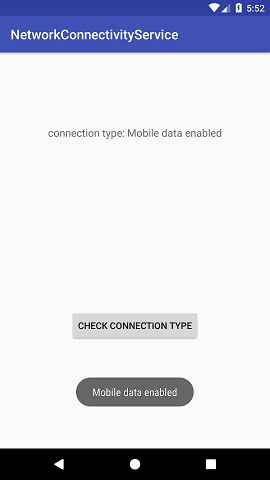Android Tutorial
Android Widgets
- UI Widgets
- Android Button
- Android Toast
- Android Custom Toast
- Android ToggleButton
- Android CheckBox
- Android Custom CheckBox
- Android RadioButton
- Android Dynamic RadioButton
- Custom RadioButton
- AlertDialog
- Spinner
- Auto Complete Text View
- ListView
- Custom ListView
- RatingBar
- WebView
- SeekBar
- DatePicker
- TimePicker
- Analog clock and Digital clock
- ProgressBar
- ScrollView Vertical
- HorizontalScrollView
- Image Switcher
- Image Slider
- ViewStub
- TabLayout
- TabLayout with FrameLayout
- SearchView
- SearchView on ToolBar
- EditText with TextWatcher
Activity and Intents
Android Fragments
Android Menu
Android Service
Android AlarmManager
Android Storage
Android SQLite
XML and JSON
Android Multimedia
Android Speech
Android Telephony
Android Device
Camera Tutorial
Sensor Tutorial
Android Graphics
Android Animation
Android Web Service
Android Examples
- QR Code / Bar Code Scanner
- RSS Feed Reader
- Volley Library Fetching JSON Data from URL
- Linkify Example
- Introduction Slider (Launch very first time when app start)
- RecyclerView List
- Swipe to Delete RecyclerView items with UNDU
- Swipe to refresh Android Activity
- Volley Library - Registration, Log-in, and Log-out
- Network Connectivity Services
- Firebase Authentication - Google Login
- Android Notification
- Using Google reCAPTCHA in Android Application
Android Social
Android Versions
Android Misc
- Android Device Manager
- Android Studio
- Android Auto
- Android to Mac
- Android Messages
- Android TV
- Android Screenshot
- Android Pay
- Android Watch
- Android Phones
- Android Tablet
- Android Find My Phone
- Android One
- Android Wear OS
- Android Data Recovery
- Android Antivirus
- Android x86
- Android Emulator for PC
- Android File Manager
- Android ad blocker
- Android Podcast App
- Fortnite Android an Epic Game
- FaceTime on Android
- ShowBox for Android
- Android App Store
- Virus Removal for Android
- cache in Android
- Root Android Device
- Android Screen Recorder
- block a number
- Canon printer app
- Wireless HP printer app
- How to Update Android
- iMessage for Android
- iCloud for Android
- Best Call Recorder
- Videoder Android
- YouTube Video Downloader
- Airdrop for Android
- RoboKiller for Android
- Clean my Android Phone
- How to hide apps, files, and photos on Android
- Best weather apps with widgets for Android
- Android File Transfer for Mac
- Mobdro for Android
- Screen Mirroring in Android
- Stock market apps for Android
- How to turn On or Off safe mode on Android
- Best browsers for Android
- Best clocks for Android
- Best email apps for Android
- Music player for Android
- Android smartwatch for women
- Best keyboard for Android
- Best messaging app for Android
Android MCQ
Android Interview
Android Quiz
Network Connectivity Services
Android network connectivity services allow us to check the network connectivity information of the device. It is very important to check the internet connection of the device while performing the task which is based on internet service such as fetching data from the server (internet) or writing data to the server.
Using Android Network Connectivity Services we can also determine the types of a network of android device. It may be of types TYPE_WIFI (wifi), TYPE_MOBILE (mobile), TYPE_BLUETOOTH (Bluetooth), etc.
Android Network Connectivity Service Example
Let's create a simple example to check the network connectivity of the device as well as its type.
To access the network connectivity of a device, we need to provide the network access permission in AndroidMenifest.xml file.
In the activity_main.xml file of layout add the following code. For accessing the network state of a device, there is no requirement of the layout file. Here, we are using the activity_main.xml file only for storing the state of network type.
activity_main.xml
<android.support.constraint.ConstraintLayout xmlns:android="http://schemas.android.com/apk/res/android"
xmlns:app="http://schemas.android.com/apk/res-auto"
xmlns:tools="http://schemas.android.com/tools"
android:layout_width="match_parent"
android:layout_height="match_parent"
tools:context="example.javatpoint.com.networkconnectivityservice.MainActivity">
<TextView
android:id="@+id/textView"
android:layout_width="wrap_content"
android:layout_height="wrap_content"
android:textSize="16dp"
android:layout_marginBottom="8dp"
android:layout_marginEnd="8dp"
android:layout_marginStart="8dp"
android:layout_marginTop="8dp"
android:contentDescription="networkstate"
android:text="Network state ?"
app:layout_constraintBottom_toBottomOf="parent"
app:layout_constraintEnd_toEndOf="parent"
app:layout_constraintRight_toRightOf="parent"
app:layout_constraintStart_toStartOf="parent"
app:layout_constraintTop_toTopOf="parent"
app:layout_constraintVertical_bias="0.183" />
<Button
android:id="@+id/button"
android:layout_width="wrap_content"
android:layout_height="wrap_content"
android:layout_marginEnd="8dp"
android:layout_marginStart="8dp"
android:text="Check Connection Type"
android:layout_marginTop="392dp"
app:layout_constraintEnd_toEndOf="parent"
app:layout_constraintStart_toStartOf="parent"
app:layout_constraintTop_toTopOf="parent" />
</android.support.constraint.ConstraintLayout>
Create a java class named as NetworkState.java. This class contains a getConnectivityStatus() method which returns the constant integer value on the basis of current network connection.
The code context.getSystemService(Context.CONNECTIVITY_SERVICE) is used to return the instance of the ConnectivityManager class which access the network properties.
NetworkState.java
import android.content.Context;
import android.net.ConnectivityManager;
import android.net.NetworkInfo;
public class NetworkState {
public static int TYPE_NOT_CONNECTED = 0;
public static int TYPE_WIFI = 1;
public static int TYPE_MOBILE = 2;
public static int getConnectivityStatus(Context context) {
ConnectivityManager cm = (ConnectivityManager) context.getSystemService(Context.CONNECTIVITY_SERVICE);
NetworkInfo activeNetwork = cm.getActiveNetworkInfo();
if (null != activeNetwork) {
if(activeNetwork.getType() == ConnectivityManager.TYPE_WIFI)
return TYPE_WIFI;
if(activeNetwork.getType() == ConnectivityManager.TYPE_MOBILE)
return TYPE_MOBILE;
}
return TYPE_NOT_CONNECTED;
}
public static String getConnectivityStatusString(Context context) {
int conn = NetworkState.getConnectivityStatus(context);
String status = null;
if (conn == NetworkState.TYPE_WIFI) {
status = "Wifi enabled";
} else if (conn == NetworkState.TYPE_MOBILE) {
status = "Mobile data enabled";
} else if (conn == NetworkState.TYPE_NOT_CONNECTED) {
status = "Not connected to Internet";
}
return status;
}
}
Create a receiver class named as NetworkReceiver.java and extends the BroadcastReciever class. This class handles the changes occur in the network state of a device. The onReceive() method of BroadcastReciever class called when the network state of device changes.
NetworkReceiver.java
import android.content.BroadcastReceiver;
import android.content.Context;
import android.content.Intent;
import android.widget.Toast;
public class NetworkReceiver extends BroadcastReceiver {
static String status =null;
@Override
public void onReceive(Context context, Intent intent) {
status = NetworkState.getConnectivityStatusString(context);
Toast.makeText(context, status, Toast.LENGTH_LONG).show();
if(status == "Wifi enabled"){
//your code when wifi enable
}
else if(status=="Mobile data enabled"){
//your code when TYPE_MOBILE network enable
}
else if(status=="Not connected to Internet"){
//your code when no network connected
}
}
}
In the MainActivity.java class, we are displaying the network state of a device in TextView by clicking the Button.
MainActivity.java
import android.support.v7.app.AppCompatActivity;
import android.os.Bundle;
import android.view.View;
import android.widget.Button;
import android.widget.TextView;
import android.widget.Toast;
public class MainActivity extends AppCompatActivity {
Button button;
TextView textView;
@Override
protected void onCreate(Bundle savedInstanceState) {
super.onCreate(savedInstanceState);
setContentView(R.layout.activity_main);
button = findViewById(R.id.button);
textView = findViewById(R.id.textView);
button.setOnClickListener(new View.OnClickListener() {
@Override
public void onClick(View v) {
NetworkReceiver receiver = new NetworkReceiver() ;
String networkStatus = receiver.status;
textView.setText("connection type: "+networkStatus);
Toast.makeText(getApplicationContext(), networkStatus, Toast.LENGTH_LONG).show();
}
});
}
}
In the AndroidMenifest.xml file, add the network access permission and receiver class that handles the changes occur in BroadcastReceiver class.
AndroidMenifest.xml
<manifest xmlns:android="http://schemas.android.com/apk/res/android"
package="example.javatpoint.com.networkconnectivityservice">
<uses-permission android:name="android.permission.ACCESS_NETWORK_STATE"/>
<uses-permission android:name="android.permission.INTERNET"/>
<application
android:allowBackup="true"
android:icon="@mipmap/ic_launcher"
android:label="@string/app_name"
android:roundIcon="@mipmap/ic_launcher_round"
android:supportsRtl="true"
android:theme="@style/AppTheme">
<activity android:name=".MainActivity">
<intent-filter>
<action android:name="android.intent.action.MAIN" />
<category android:name="android.intent.category.LAUNCHER" />
</intent-filter>
</activity>
<receiver
android:name=".NetworkReceiver"
android:enabled="true">
<intent-filter>
<action android:name="android.net.conn.CONNECTIVITY_CHANGE" />
<action android:name="android.net.wifi.WIFI_STATE_CHANGED" />
</intent-filter>
</receiver>
</application>
</manifest>
Output




